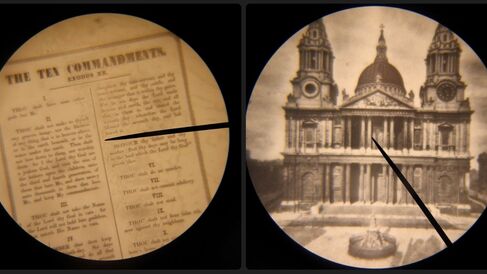Microphotographs

John Benjamin Dancer, a Manchester-based instrument maker and inventor, is now best known as the pioneer of microphotography (the production of photographs viewable only through a microscope). He developed the process during the 1840s, and lived to see it become extremely popular, though its first serious use only occurred during the Franco-Prussian War of 1870-71.
Invention and development of microphotography
This small collection of microphotographs was found in the case of a French microscope, and were made by John Benjamin Dancer (1812-1887), the Manchester-based instrument maker and pioneer of the technique. It was not long after the invention of modern photographic technique that Dancer attached a 1.5-inch focal length microscopic lens to a camera, in order to magnify the image.
By the 1850s Dancer had developed a method of producing microphotographs containing a full picture occupying only 1/16th of an inch. Microphotographs were made of portraits, monuments, and many popular subject. A list (view image) published around 1870 demonstrates the development of Dancer's range of subjects, which in turn reflects the prevailing interests of his customers, for example:
"1. Sturgeon's Tablet [an inscription in a church. This was Dancer's first microphotograph, and was used as evidence of his being the inventor of the technique]. [...]
8. Prince Albert.
9. Napoleon III. [...]
16. Photograph - Fountains Abbey. [...]
25. Shakespeare.
26. The Lord's Prayer, Illuminated.
27. The Lord's Prayer, Plain. [...]
33. The Photographer. [...]
51. £20 Bank Note."
Serious uses
The microphotograph was seen by some as being a frivolous item, with no practical application. However, after microphotography was used to transfer sensitive information in 1870, during the Franco-Prussian war, the usefulness of the technique began to be recognised.
The most prominent descendant of the microphotograph is the microfilm technique, now used by libraries to acquire copies of rare books and by large institutions to record vast quantities of information. Original documents are photographed onto a reel of film, which is viewed using a special reader that projects the image onto a screen. One main advantage of the microfilm technique is that a great deal of information can be stored in a small space. Also, by using the microfilm copy, libraries can prevent fragile originals from being damaged through handling.
Boris Jardine
Boris Jardine, 'A collection of John Benjamin Dancer microphotographs', Explore Whipple Collections, Whipple Museum of the History of Science, University of Cambridge, 2006
